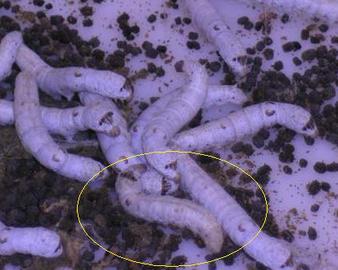
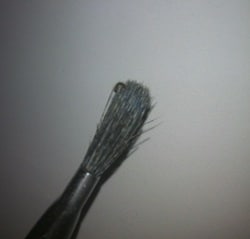
Silkworms are the larva of the silk moth (bombyx mori), this guide promotes a simple method of rearing silkworm larvae. There are a few underlying essentials, ensure that they are cleaned regularly, that you meet their heating and humidity requirements through every instar and ensuring that they are fed often enough are pretty much the main factors of silkworm larval rearing. I have tried to note these key points where needed with other pointers to look out for along the way. Silkworm rearing is about finding the most effective and least time consuming method that works for you.
In this guide, I mention the silkworms “instars”, instars are the name given to the stage of larval rearing following each moult that the larva go through, all in all silkworm larvae moult their skin four times during the larval period, going through a total of 5 instars.
There are many tried and tested methods of silkworm rearing, this guide is based on the use of mulberry chow for feeding as many are unable to source large amounts of fresh mulberry leaves here in the UK (they eat ridiculous amounts of food! In total, their growth throughout the larval stages from the first instar through to the spinning stage is immense, they grow 10,000 times their initial size in fact!!). An essential factor to healthy silkworms is the cleanliness of their environment, remove their frass (silkworm poop) regularly to prevent the build up of mould (one of the biggest killers in silkworm rearing!), ensuring that their containers are never too condensed etc. It must be remembered that young silkworm larvae are very delicate, especially at the younger stages of silkworm larval rearing, so extreme care must be taken at all times, if you are transferring small larvae, I advise to use a soft paintbrush (can you see the tiny little guy below?).
In order to hatch silkworm eggs, the temperature should be within the range of 78f-85f, with a humidity level of 85-90% and daylight photoperiod of 12L:12D, these requirements are essential in order to obtain complete hatching. Incubation under these conditions lasts for approximately 7-10 days.
A day or so before the eggs begin to hatch you will find that the eggs have gone from a dark purple/grey colour to a light blue/grey colour, this is because the larvae inside the egg, eat the serosa membrane prior to hatching.
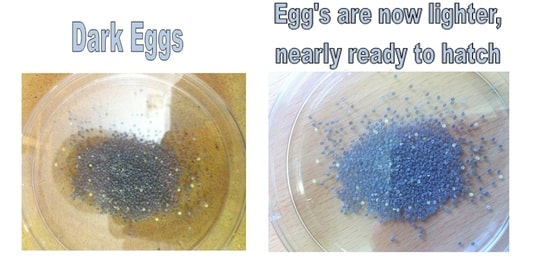
Generally after the first few eggs begin to hatch you will find that it takes around 2 days for all of the larvae to hatch out, do not feed the larvae on the first day that you notice hatching, wait 24 hours from this time, this is long enough to ensure that the fertile eggs have hatched without depriving the first hatchers of their feed. If the first hatchers are fed to early, the moist mulberry food on the eggs that haven’t yet hatched, may prevent them from hatching at all!
One way to synchronize hatching, when you see that the eggs have begun to lighten in colour, we know that the larvae are nearly ready to hatch, put the eggs in complete darkness for 1 day (still within the same heated conditions). The following day, remove the eggs from darkness and place in the light (not under direct sunlight, this can be too hot for them!), this way you will find that they should all hatch at the same time (within a few hours).
First Feed
Once the larvae are ready for their first feed, place a small amount of insect mesh over the top of the young larvae and grate some of the mulberry chow over them (not a large amount of food as the weight of the mesh may squash them). You will find that the larvae will begin to climb through the mesh and onto the chow. After a few hours and most of the larvae have transferred onto the food, remove the mesh from the container and place it in a new disinfected container. If any silkworms remain, use a very fine paint brush to transfer the remaining larvae into the new container, making sure that you are very careful as the young larvae are very delicate.
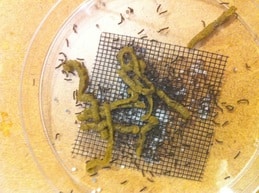
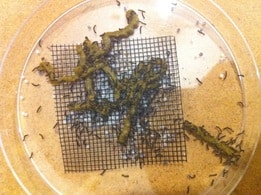
Now leave the larvae in their new container over night in the same heated conditions with humidity at around 85%, make sure that their container has ventilation.
The second day of their first instar, check their condition, remove any desiccated chow and grate new food over them. When checking silkworms daily if you find that several hours after a feed they have eaten all of the food that you gave them, feed them again, their appetite seems to never end..!
The same procedure should be applied on the third day, ensure that desiccated diet is replaced. At this point you should now find that the larvae are white/grey in colour and are now clearly visible on the diet.
The fourth day of larval rearing you will notice that the larvae have begun their first moulting period. Their bodies are translucent and they become to fix to the substrate with silk threads. Again, replacement chow should be added if the existing chow is very dry (in this case a very small quantity). The fifth day you will see that the majority of larvae are moulting. Some of them have already moulted and have big light heads (shown in red) some of them are still undergoing the moulting process and are darker in appearance and still have a smaller head (shown in yellow).
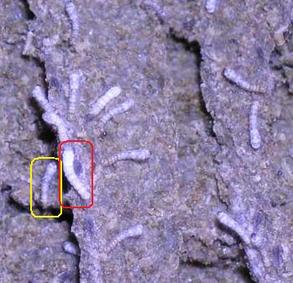
At this point the food must be dry, if not, the first larvae to have completed moulting will continue to feed while the other larvae will begin eating late. Keep their container lid open at this point and do not add any food.
The sixth day the majority of larvae will have moulted, you can fully distinguish the black shiny large head, the opaque body, greyish in colour (below, circled in red). Larvae still moulting are reddish-brown and still translucent, and their head capsule is comparatively small (below, in yellow). Silk threads should be clearly visible on the food. Now it is time to give them food again, but before you do so, place a layer of mesh over the larvae. Slice thin strips of the chow over the mesh and leave the silkworms to climb onto it and begin feeding (this should take around 3 hours). Please note that the larvae will climb very quickly onto the new food, only if the old food is completely desiccated. If old chow remains, ensure that this is removed from the container, if you leave the old food in their container when putting new food on top, it becomes a breeding ground for mould..!
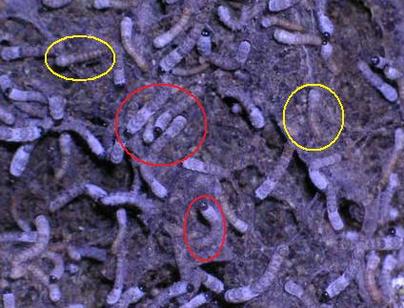
Please note: If there are many larvae in the old container over the old food then they are still moulting. You can leave them without food for the following day, once the larvae have shed and are ready to begin the second instar they are ready to start in the same manner as the larvae that moulted on the sixth day (generally this is not necessary, only if the hatching was not synchronized).
The following day is the second day of the second instar, if their food has been eaten then replace with new thin slices of the chow, ensuring that any old chow has been removed.
The third day of the second instar the larvae will have begun moulting again as the second instar is the shortest. On this day the container lid must be removed and the larvae must not be fed in order to let the existing chow dry out.
The day after this place new netting over the larvae and give them another feed of thinly sliced mulberry chow. Again, the larvae climb through the mesh themselves after 2-3 hours, now they can be easily transferred again to a new, clean container. Place the lid on their container ensuring that there is ventilation, temperature is now increased to 80f and humidity levels of 75%. This is the first day of the third instar.

On the second day of the third instar remove any dried out food and feed again.
The third day, new thin slices of chow should be placed where the existing has been eaten or desiccated. Ensure removal of any old/dry chow.
On the fourth day of the third instar, larvae are beginning moulting for the following instar. Do not feed at this point as they will not eat. at this stage of their development is easier to distinguish, also their old skin can be seen in their container (circled in red).
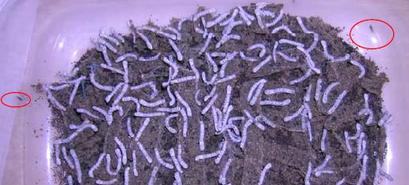
The following day the majority of larvae will have moulted to the fourth instar. Here we repeat previous steps in placing new mesh over the larvae and feeding slices of chow on top for the larvae to climb onto. The time it takes for the larvae to climb through the new mesh is comparatively shorter then it is in previous instars, as the larvae are now older and more mobile.
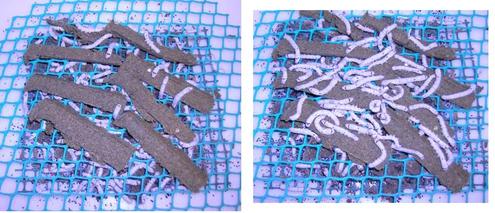
This is the first day of the fourth instar, larvae should now be transferred to a larger container, the temperature should be adjusted to around 78f and humidity around 70%, make sure that their new container has sufficient ventilation.
The second and third day of the fourth instar, again, new diet should replace any of the existing if it has dried out. Cleaning at this stage is suggested by laying new mesh on top of the larvae, feeding and transferring into their box after any frass has been removed.
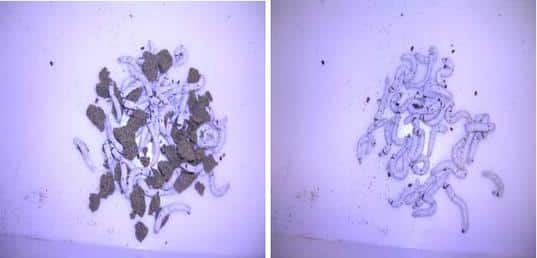
Fourth day, again, feed and remove any old chow and frass.
On the fifth day of the fourth instar, larvae will be moulting again. New chow must not be added in the box, and the container that hold the larvae should have its lid removed in order to permit complete desiccation of the chow, humidity here should be reduced to 60%.
In the picture below you can see circled in red, the skin residue that is left behind after this moult, almost looks like the dried remains of a silkworm.
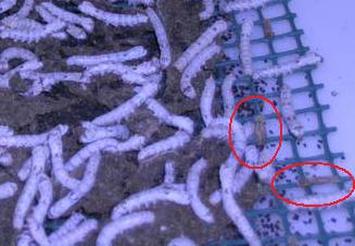
The following day the vast majority of the larvae will have moulted to the fifth instar. A new larger mesh should now be placed on the larvae and new chow applied.
Larvae should now be transferred to a new, clean container, temperature adjusted around 77f and humidity around 65%. This is the first day of the last instar.
The last instar moulting is longer than other moults (around 48 hours). If there are remaining larvae after this period that are on the old food still moulting, you can leave them without a lid on their container for the following day, when they are ready to begin the last instar, continue to rear them in the same manner as the larvae that moulted on the previous day (generally they are in a minority (around 5%), only if the rearing is not homogenous).
The second day of the last instar.
Cleaning is very important during the last instar (as you can see below, the amount of faeces following a feed), the larvae should be cleaned daily, via use of mesh, tweezers or by hand (while wearing clean gloves). Their waste should be removed from the container, and the container to be cleaned.
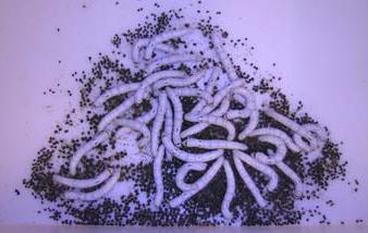
The third day of the last instar, you can see that the larvae have eaten almost all of their food here and produced a large amount of faeces. Again, cleaning and feeding must be done.
The same procedure for the fourth and fifth days of the last instar.
The sixth and seven days of the last instar you will find that the larvae begin to excrete uric acid from their gut, they release this in preparation for spinning their cocoon, this however causes high levels of humidity and therefore spinning larvae should be removed from the environment when spotted and put in a separate container for spinning. A small amount of chow should be given here to allow those still feeding to continue. Ensure that the lid is removed from their container at this point to lower the humidity (needs to be around 60%)
Mature larvae that are ready to spin can be distinguished by the change in their appearance, they become translucent to look at and begin to shrink slightly due to the excretion of uric acid, identifiable as below.
Mature larvae that are ready to spin can be identified by several indications, the excretion of uric acid, their ‘heart line’ which is the long pulsating line that runs along the dorsal (upper) part of their body (part of their circulatory system), these are sure signs that a larva is nearing pupation.
